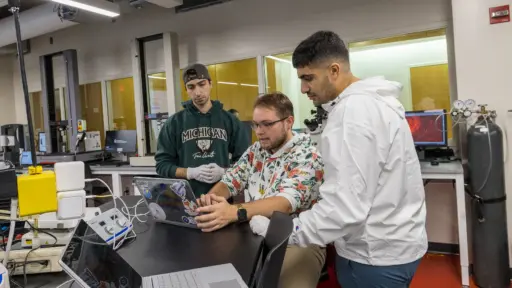As a researcher in a genomics lab, Carley Schwartz is much more familiar with the gene-editing tool CRISPR than the vast majority of the roughly 4,800 undergraduate students in the University of Wisconsin-Madison College of Engineering.
“That’s all I do in lab,” says the senior biomedical engineering major, who hopes to one day work in the biotech industry.
But that level of experience isn’t a prerequisite for students in Biomedical Engineering 602: CRISPR Genome Editing and Engineering Laboratory, a new course designed to give upper-level undergraduates like Schwartz and graduate students the practical, essential skills to use the tool. They learn the basics of cell culture and differentiation, imaging techniques, strategies for designing genomic edits, and how to sequence and analyze DNA while working with mouse cell lines.
Since its 2012 discovery—one that subsequently earned scientists Emmanuelle Charpentier and Jennifer Doudna a Nobel Prize—CRISPR-Cas9 gene-editing machinery has exploded in popularity for biomedical applications, as well as in agriculture, biomanufacturing and environmental science.
 Saha
Saha
Krishanu Saha, an associate professor of biomedical engineering at UW-Madison, has been using the genome editor in his research lab since shortly after its discovery and teaching about it in classes and workshops for the better part of a decade. But he wanted to create a dedicated, semester-long, lab-based course to allow students to work directly with the technology and get a firsthand look at its possibilities and limitations. He says he only knows of a handful of other similar courses across the country.
“People see the illustrations, they see how it works, they see the impacts on publications and companies being launched, but many people ask, ‘Well, how do you actually do it? What are the steps? How do you get CRISPR into the nucleus? Where do you get your reagents? Is it hard?’” says Saha, who’s part of the National Institutes of Health Somatic Cell Genome Editing Consortium and the National Science Foundation Center for Cell Manufacturing Technologies. “These are the questions that I think, in particular, engineers ask, because they’re thinking of how to refine the process and make it more efficient and scale up and make the technology more accessible and widespread.”
Saha’s lab uses the CRISPR-Cas9 editor to engineer T cells to attack cancer, as well as in emerging treatments for several eye diseases and other cell therapies. But students rarely get the chance to use the so-called “genetic scissors” unless, like Schwartz, they work in a research lab that deals with genomic editing.
“I didn’t have anything like this in my undergrad. We were not doing gene editing,” says Madeline Smerchansky, a PhD student in biomedical engineering and one of the three Saha lab members who helped develop the course and are serving as teaching assistants. “It doesn’t seem like a lot of people get that opportunity unless you’re in a CRISPR lab.”
 Classroom photos by Tom Ziemer
Classroom photos by Tom Ziemer
Just ask Michelle Bretl, a PhD student in communication sciences and disorders minoring in biomedical engineering who came into the course with only cursory knowledge about CRISPR. Now, she’s eager to apply it to the tissue engineering and regenerative medicine work she’s doing in the lab of BME affiliate faculty member Susan Thibeault in the Department of Surgery.
“I’m excited by the fact that it is something that people from a lot of backgrounds can do, and I think that will benefit patients in the future,” says Bretl. “It’s not this specialized thing. So much of medicine is so specialized and can cost a ton of money. This feels like we could be moving toward more accessibility.”
Saha says the equipment in the Department of Biomedical Engineering’s recently renovated teaching lab on the first floor of the Engineering Centers Building makes it possible to offer a course where students can work on mammalian cells. That’s significant, because it means the skills and techniques they’re learning will directly translate to human cells.
“We’re fortunate to have fantastic facilities, which I think reflects the commitment of both the college, the department and the donors who provided the funds and equipment to build out this space,” he says. “It takes biosafety cabinets, it takes incubators, it takes specialized equipment to work with these cell lines that are probably the most relevant for these types of therapeutic applications.”